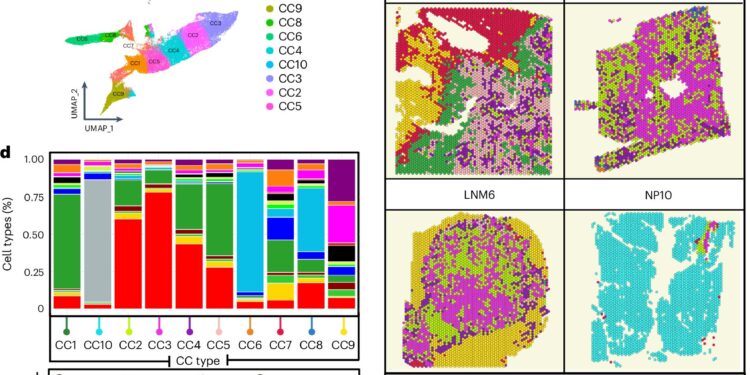Identification of pancreatic cancer architecture. Credit: Natural genetics (2024). DOI: 10.1038/s41588-024-01914-4
Researchers at Indiana University’s Melvin and Bren Simon Comprehensive Cancer Center have mapped pancreatic cancer tumor ecosystems using tissue from the primary tumor, where the cancer begins to grow in the body, and metastatic disease, or when cancer cells spread to different parts of the body. body beyond the primary tumor.
The study, recently published in Natural geneticsreveals notable differences between primary and metastatic pancreatic cancer, which could lead to new treatment strategies for this often fatal disease.
The study’s lead author, Ashiq Masood, MD, associate professor of medicine at the IU School of Medicine, used spatial transcriptomics, a method for studying a region of cells and their interactions, to discover these pancreatic cancer ecosystems.
“In about 85% of cases of pancreatic cancer, surgery is not an option because it is either too advanced or has spread to other organs like the liver,” said Masood, a researcher at the center. in the fight against cancer. “For this reason, it has been very difficult to obtain enough tumor tissue to perform sequencing of primary and metastatic tumors.”
IU and its health care partner Indiana University Health have one of the largest pancreatic cancer programs in the country, with surgeons performing more pancreatic cancer operations than any other team in the country. This places IU in a unique position to produce diverse tumor samples stored in a tissue bank for cancer research.
While pancreatic cancer accounts for less than 4% of new cancer cases in the United States, it is the third leading cause of cancer deaths each year. The National Cancer Institute estimates that more than 51,000 people will die from pancreatic cancer in the United States in 2024.
Using tumor tissue from surgical resections of pancreatic cancer and diseases that spread to the liver, pancreas and lymph nodes, IU researchers were able to study the “neighborhoods” of pancreatic cancer.
Much of the research into pancreatic cancer has previously focused on the primary tumor, but understanding how the disease spreads is crucial to developing new treatments. Masood and the research team identified seven distinct spatial neighborhoods, or spatial ecotypes, in the primary tumor and metastases. Each neighborhood has a unique composition of cells and genetic activity.
“These tumors can be seen as an ecosystem in which cancer cells and other accessory cells, whether fibroblasts, T cells or other immune cells, are interconnected and communicate with each other and with the tumor cells.” , Masood said.
For example, the vicinity of the primary pancreatic tumor had high numbers of fibroblastic cells, which contribute to the formation of connective tissue. In comparison, metastatic liver tumors contained more cancer cells that divided and multiplied rapidly.
“What was interesting was that in the same patient, we saw these different tumor ecosystems, so we might need different therapeutic strategies to target one and then the other,” Masood said.
He is now planning projects to build on this work.
“Our next goal is to study pancreatic cancer ecosystems at single-cell resolution while retaining spatial context,” Masood said.
“In addition to patient samples, we will use models to explore the functions of different spatial ecotypes and study the presence and roles of ecotype-specific genes in all patients. Finally, we aim to determine whether there are Patient-specific ecotypes and their influence on prognosis and treatment response, which will be essential for the development of effective combination therapies.
Other authors from the IU Cancer Center participating in the study include Anita Turk, Michael House, Y. Alan Wang, Nicholas J. Zyromski, Mateusz Opyrchal, Kelvin P. Lee and Heather O’Hagan; and other IU authors are Ateeq M. Khaliq, Meenakshi Rajamohan, Omer Saeed, Kimia Mansouri and Asif Adil.
More information:
Ateeq M. Khaliq et al, Spatial transcriptomic analysis of primary and metastatic pancreatic cancers highlights tumor microenvironmental heterogeneity, Natural genetics (2024). DOI: 10.1038/s41588-024-01914-4
Provided by Indiana University
Quote: Pancreatic cancer tumor map reveals notable differences between primary and metastatic disease (October 4, 2024) retrieved October 4, 2024 from
This document is subject to copyright. Except for fair use for private study or research purposes, no part may be reproduced without written permission. The content is provided for informational purposes only.



